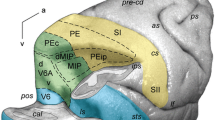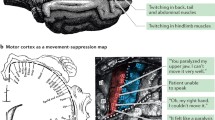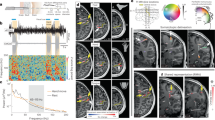Summary
Single cell activity was examined in the three motor fields of the monkey frontal cortex with the aim of comparing the neuronal activity preceding movements triggered by a visual signal to that preceding nontriggered (self-paced) movements. The following findings emerged from this study. 1. Neuronal activity changes were observed at two different phases in relation to the movement onset; the shortlead type observed within 480 ms prior to the movement onset and the long-lead type, beginning earlier (typically 1 to 2 s). 2. Neurons in both the supplementary motor area (SMA) and premotor area (PM) exhibited the short-lead activity changes prior to the triggered and self-paced movement. Their magnitudes were similar in 63% of SMA and in 36% of PM neurons, whether the movement was triggered or self-paced. 3. SMA neurons, as a whole, were not less active before the triggered than self-paced movement. 4. On the other hand, as many as 92 PM neurons (61%) were related exclusively or peferentially to the triggered movement. 5. The majority of precentral motor cortex (MC) neurons exhibited similar activity changes before the two modes of movement initiation. 6. The long lead type of activity changes were observed mainly prior to the self-paced and much less frequently before the triggered movement. They were particularly abundant among SMA neurons. These results do not support the simple dichotomy hypothesis that SMA primarily takes part in self-paced movement and PM is only involved in visually triggered movement. However, PM neurons show relatively more prominent responses to the visual trigger signal and SMA neurons are intimately related to a long-lasting process leading to initiation of the self-paced movement.
Similar content being viewed by others
References
Boschert J, Hnik RF, Deecke L (1983) Finger movement versus toe movement-related potentials: further evidence for supplementary motor area (SMA) participation prior to voluntary action. Exp Brain Res 52: 73–80
Brinkman C, Porter R (1979) Supplementary motor area in the monkey. Activity of neurons during performance of a learned motor task. J Neurophysiol 42: 681–709
Chapman CE, Spidalieri C, Lamarre Y (1986) Activity of dentate neurons during arm movements triggered by visual, auditory, and somesthetic stimuli in the monkey. J Neurophysiol 55: 203–226
Cheney PD, Fetz EE (1980) Functional classes of primate corticomotoneuronal cells and their relation to active force. J Neurophysiol 44: 773–791
Deecke L, Kornhuber HH (1978) An electrical sign of participation of the mesial ‘supplementary’ motor cortex in human voluntary finger movement. Brain Res 159: 473–476
Eccles JC (1982) The initiation of voluntary movements by the supplementary motor area. Arch Psychiatr Nervenkr 231: 423–441
Evarts EV (1968) A technique for recording activity of subcortical neurons in moving animals. Electroenceph Clin Neurophysiol 24: 83–86
Evarts EV, Fromm C, Kroller J, Jennings VA (1983) Motor cortex control of finely graded forces. J Neurophysiol 49: 1199–1215
Evarts EV, Wise SP (1984) Basal ganglia outputs and motor control. In: Functions of the basal ganglia. Ciba Foundation Symposium 107. Pitman, London, pp 83–96
Godschalk M, Lemon RN, Kuypers HGJM, Ronday K (1984) Cortical afferents and efferents of monkey postarcuate area. An anatomical and electrophysiological study. Exp Brain Res 56: 420–424
Godschalk M, Lemon RN, Nijs HGT, Kuypers HGJM (1981) Behavior of neurons in monkey periarcuate and precentral cortex before and during visually guided arm and hand movements. Exp Brain Res 44: 113–116
Goldberg G (1985) Supplementary motor area structure and function: review and hypothesis. Behav Brain Sci 8: 567–615
Haider M, Groll-Knapp E, Gangberger JA (1981) Event-related slow (DC) potentials in the human brain. Rev Physiol Biochem Pharmacol 88: 125–197
Halsband U, Passingham R (1982) The role of premotor and parietal cortex in the direction of action. Brain Res 240: 368–372
Hashimoto S, Gemba H, Sasaki K (1981) Distribution of slow cortical potentials preceding self-paced hand and hindlimb movements in the premotor and motor areas of monkeys. Brain Res 224: 247–259
Humphrey DR (1979) On the cortical control of visually directed reaching: contributions by nonprecentral motor areas. In: Talbot RE, Humphrey DR (eds) Posture and movement. Raven, New York, pp 51–112
Ingvar DH, Philipson L (1977) Distribution of cerebral blood flow in the dominant hemisphere during motor ideation and motor performance. Ann Neurol 2: 230–237
Jürgens U (1984) The efferent and afferent connections of the supplementary motor area. Brain Res 300: 63–81
Kubota K, Hamada I (1978) Visual tracking and neuron activity in the post-arcuate area in monkeys. J Physiol Paris 74: 297–313
Kurata K, Okano K, Tanji J (1985) Distribution of neurons related to a hindlimb as opposed to forelimb movement in the monkey premotor cortex. Exp Brain Res 60: 188–191
Kurata K, Tanji J (1986) Premotor cortex neurons in macaques: activity before distal and proximal forelimb movements. J Neurosci 6: 403–411
Lamarre Y, Busby L, Spidalieri G (1983) Fast ballistic arm movements triggered by visual, auditory, and somesthetic stimuli in the monkey. I. Activity of precentral cortical neurons. J Neurophysiol 50: 1343–1358
Libet B, Wright EW, Gleason CA (1983) Preparation — or intention — to act, in relation to pre-event potentials recorded at the vertex. Electroenceph Clin Neurophysiol 56: 367–372
Marsden CD (1982) The mysterious motor function of the basal ganglia: the Robert Wartenberg lecture. Neurology 323: 524–539
Moll L, Kuypers HGJM (1977) Premotor cortical ablations in monkeys: contralateral changes in visually guided reaching behavior. Science 198: 317–319
Muakkasa KF, Strick PL (1979) Frontal lobe inputs to primate motor cortex: evidence for four somatotopically organized ‘premotor’ areas. Brain Res 177: 176–182
Murray EA, Coulter JB (1981) Organization of corticospinal neurones in the monkey. J Comp Neurol 195: 339–365
Okano K, Tanji J (1986) Comparison of triggered movementrelated and self-paced movement-related neuronal activities in primate frontal motor fields. Neurosci Res Suppl 3: S89
Petrides M, Pandya DN (1984) Projections to the frontal cortex from the posterior parietal region in the rhesus monkey. J Comp Neurol 228: 105–116
Rizzolatti G, Matelli M, Pavesi G (1983) Deficits in attention and movement following the removal of postarcuate (area 6) and prearcuate (area 8) cortex in macaque monkeys. Brain 106: 655–673
Rizzolatti G, Scandolara C, Matelli M, Gentilucci M (1981) Afferent properties of periarcuate neurons in macaque monkeys. 2. Visual responses. Behav Brain Res 2: 147–163
Roland PE, Larsen B, Lassen NA, Skinhoj E (1980a) Supplementary motor area and other cortical areas in organization of voluntary movements in man. J Neurophysiol 43: 118–136
Roland PE, Skinhoj E, Lassen NA, Larsen B (1980) Different cortical areas in man in organization of voluntary movements in extrapersonal space. J Neurophysiol 43: 137–150
Sanides F (1964) The cuto-myeloarchitecture of the human frontal lobe and its relation to phylogenetic differentiation of the cerebral cortex. J Hirnforsch 6: 269–282
Schell GR, Strick PL (1984) The origin of thalamic inputs to the arcuate premotor and supplementary motor areas. J Neurosci 4: 539–560
Sessle BJ, Wiesendanger M (1982) Structural and functional definition of the motor cortex in the monkey (Macaca fascicularis). J Physiol (Lond) 323: 245–265
Talairach J, Bancaud J, Geier S, Bordas-Ferrer M, Bonis A, Szikla G, Rusu M (1973) The cingulate gyrus and behavior. Electroenceph Clin Neurophysiol 34: 45–52
Tanji J, Taniguchi K, Saga T (1980) Supplementary motor area: neuronal response to motor instructions. J Neurophysiol 43: 60–68
Tanji J, Kurata K (1982) Comparison of movement-related activity in two cortical motor areas of primates. J Neurophysiol 48: 633–653
Tanji J, Kurata K (1985) Contrasting neuronal activity in supplementary and precentral motor cortex of monkeys. I. Responses to instructions determining motor responses to forthcoming signals of different modalities. J Neurophysiol 53: 129–141
Weinrich M, Wise SP (1982) The premotor cortex of the monkey. J Neurosci 2: 1329–1345
Weinrich M, Wise SP, Mauritz K-M (1984) A neurophysiological study of the premotor cortex in the rhesus monkey. Brain 107: 385–414
Wiesendanger M (1981) Organization of secondary motor areas of cerebral cortex. In: Brooks (ed) Handbook of physiology. The nervous system, Vol II. Motor control. Am Physiol Soc, Washington, pp 1121–1147
Wiesendanger M (1986) Recent developments in studies of the supplementary motor area of primates. Rev Physiol Biochem Pharmacol 103: 1–59
Wiesendanger R, Wiesendanger M (1985) The thalamic connections with medial area 6 (supplementary motor cortex) in the monkey (Macaca fascicularis). Exp Brain Res 59: 91–104
Wise SP (1985) The primate premotor cortex: past, present and preparatory. Ann Rev Neurosci 8: 1–19
Wise SP, Mauritz K-H (1985) Set-related neuronal activity in the premotor cortex of rhesus monkeys: effects of changes in motor set. Proc R Soc Lond Biol 223: 331–354
Author information
Authors and Affiliations
Additional information
Supported by Special Coordination Funds for Promoting Science and Technology from Science and Technology Agency of Japan (Research on the development of basic technologies for brain function analysis)
Rights and permissions
About this article
Cite this article
Okano, K., Tanji, J. Neuronal activities in the primate motor fields of the agranular frontal cortex preceding visually triggered and self-paced movement. Exp Brain Res 66, 155–166 (1987). https://doi.org/10.1007/BF00236211
Received:
Accepted:
Issue Date:
DOI: https://doi.org/10.1007/BF00236211




